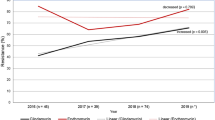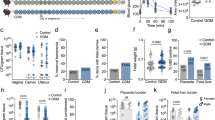Abstract
Background
The potential factors associated with group B streptococcus (GBS) vertical transmission have not been studied in detail.
Study design
A prospective cohort study was conducted to recruit 1815 mother–neonate pairs for GBS analysis. Pearson’s chi-squared tests and generalized linear models were used to explore the risk factors for neonatal GBS colonization.
Results
The rate of GBS vertical transmission was 14.1%. GBS colonization in all neonates was significantly associated with maternal GBS colonization, mode of delivery, episiotomy, number of prenatal vaginal exams, parity, and hypertension. For neonates born to GBS-positive mothers, GBS vertical transmission was associated with the mode of delivery, episiotomy, and sexually transmitted diseases. For neonates born to GBS-negative mothers, neonatal GBS colonization was associated with the number of prenatal vaginal exams, parity, and hypertension.
Conclusion
These findings suggest the need for prenatal GBS screening for pregnant women and intrapartum antimicrobial prophylaxis for GBS-colonized women.
This is a preview of subscription content, access via your institution
Access options
Subscribe to this journal
Receive 12 print issues and online access
$259.00 per year
only $21.58 per issue
Buy this article
- Purchase on Springer Link
- Instant access to full article PDF
Prices may be subject to local taxes which are calculated during checkout

Similar content being viewed by others
References
Van Dyke MK, Phares CR, Lynfield R, Thomas AR, Arnold KE, Craig AS, et al. Evaluation of universal antenatal screening for group B streptococcus. N Engl J Med. 2009;360:2626–36.
Schrag S, Gorwitz R, Fultz-Butts K, Schuchat A. Prevention of perinatal group B streptococcal disease. Revis Guidel Cdc MMWR Recomm Rep. 2002;51:1–22.
Berardi A, Rossi C, Creti R, China M, Gherardi G, Venturelli C, et al. Group B streptococcal colonization in 160 mother-baby pairs: a prospective cohort study. J Pediatr. 2013;163:1099–104.
Stoll BJ, Schuchat A. Maternal carriage of group B Streptococci in developing countries. Pediatr Infect Dis J. 1998;17:499–503.
Verani JR, McGee L, Schrag SJ. Prevention of perinatal group B streptococcal disease–revised guidelines from CDC, 2010. MMWR Recomm Rep. 2010;59:1–36.
Schuchat A, Oxtoby M, Cochi S, Sikes RK, Hightower A, Plikaytis B, et al. Population-based risk factors for neonatal group B streptococcal disease: results of a cohort study in metropolitan Atlanta. J Infect Dis. 1990;162:672–7.
Baker CJ, Barrett FF, Yow MD. The influence of advancing gestation on group B streptococcal colonization in pregnant women. Am J Obstet Gynecol. 1975;122:820–3.
Yancey MK, Schuchat A, Brown LK, Ventura VL, Markenson GR. The accuracy of late antenatal screening cultures in predicting genital group B streptococcal colonization at delivery. Obstet Gynecol. 1996;88:811–5.
Picard FJ, Bergeron MG. Laboratory detection of group B Streptococcus for prevention of perinatal disease. Eur J Clin Microbiol Infect Dis. 2004;23:665–71.
Seoud M, Nassar AH, Zalloua P, Boghossian N, Ezeddine J, Fakhoury H, et al. Prenatal and neonatal Group B Streptococcus screening and serotyping in Lebanon: incidence and implications. Acta Obstet Gynecol Scand. 2010;89:399–403.
Dahan-Saal J, Gerardin P, Robillard PY, Barau G, Bouveret A, Picot S, et al. [Determinants of group B streptococcus maternal colonization and factors related to its vertical perinatal transmission: case-control study]. Gynecol Obstet Fertil. 2011;39:281–8.
Krasnianin E, Skret-Magierlo J, Witalis J, Barnas E, Kluz T, Koziel A, et al. The incidence of streptococcus group B in 100 parturient women and the transmission of pathogens to the newborn. Ginekol Pol. 2009;80:285–9.
Adair CE, Kowalsky L, Quon H, Ma D, Stoffman J, McGeer A, et al. Risk factors for early-onset group B streptococcal disease in neonates: a population-based case-control study. CMAJ. 2003;169:198–203.
Rosenstein NE, Schuchat A. Opportunities for prevention of perinatal group B streptococcal disease: a multistate surveillance analysis. The neonatal group B streptococcal disease study group. Obstet Gynecol. 1997;90:901–6.
Al-Sweih N, Hammoud M, Al-Shimmiri M, Jamal M, Neil L, Rotimi V. Serotype distribution and mother-to-baby transmission rate of streptococcus agalactiae among expectant mothers in Kuwait. Arch Gynecol Obstet. 2005;272:131–5.
Wakimoto H, Yano H, Baba S, Okuzumi K, Okamoto N, Wakimoto Y, et al. Prevention of vertical transmission of group B streptococcus. Kansenshogaku Zasshi. 2005;79:549–55.
Yang MJ, Sun PL, Wen KC, Chao KC, Chang WH, Chen CY, et al. Prevalence of maternal group B streptococcus colonization and vertical transmission in low-risk women in a single institute. J Chin Med Assoc. 2012;75:25–8.
Namavar Jahromi B, Poorarian S, Poorbarfehee S. The prevalence and adverse effects of group B streptococcal colonization during pregnancy. Arch Iran Med. 2008;11:654–7.
Berardi A, Rossi C, Biasini A, Minniti S, Venturelli C, Ferrari F, et al. Efficacy of intrapartum chemoprophylaxis less than 4 h duration. J Matern Fetal Neonatal Med. 2011;24:619–25.
Benitz WE, Gould JB, Druzin ML. Risk factors for early-onset group B streptococcal sepsis: estimation of odds ratios by critical literature review. Pediatrics. 1999;103:e77.
Petry CJ, Ong KK, Hughes IA, Acerini CL, Dunger DB. Associations between bacterial infections and blood pressure in pregnancy. Pregnancy Hypertens. 2017;10:202–6.
Rustveld LO, Kelsey SF, Sharma R. Association between maternal infections and preeclampsia: a systematic review of epidemiologic studies. Matern Child Health J. 2008;12:223–42.
Kunze M, Ziegler A, Fluegge K, Hentschel R, Proempeler H, Berner R. Colonization, serotypes and transmission rates of group B streptococci in pregnant women and their infants born at a single university center in Germany. J Perinat Med. 2011;39:417–22.
Joachim A, Matee MI, Massawe FA, Lyamuya EF. Maternal and neonatal colonisation of group B streptococcus at muhimbili national hospital in Dar es Salaam, Tanzania: prevalence, risk factors and antimicrobial resistance. BMC Public Health. 2009;9:437.
Katz V, Bowes WA Jr.. Perinatal group B streptococcal infections across intact amniotic membranes. J Reprod Med. 1988;33:445–9.
Gray KJ, Kafulafula G, Matemba M, Kamdolozi M, Membe G, French N. Group B streptococcus and HIV infection in pregnant women, Malawi, 2008-2010. Emerg Infect Dis. 2011;17:1932–5.
Epalza C, Goetghebuer T, Hainaut M, Prayez F, Barlow P, Dediste A, et al. High incidence of invasive group B streptococcal infections in HIV-exposed uninfected infants. Pediatrics. 2010;126:e631–8.
Stevenson KB, Murphy CL, Samore MH, Hannah EL, Moore JW, Barbera J, et al. Assessing the status of infection control programs in small rural hospitals in the western United States. Am J Infect Control. 2004;32:255–61.
Boyce JM. Hospital epidemiology in smaller hospitals. Infect Control Hosp Epidemiol. 1995;16:600–6.
Britt MR, Burke JP, Nordquist AG, Wilfert JN, Smith CB. Infection control in small hospitals. Prevalence surveys in 18 institutions. JAMA. 1976;236:1700–3.
Kaye KS, Engemann JJ, Fulmer EM, Clark CC, Noga EM, Sexton DJ. Favorable impact of an infection control network on nosocomial infection rates in community hospitals. Infect Control Hosp Epidemiol. 2006;27:228–32.
Joynt KE, Orav EJ, Jha AK. Mortality rates for Medicare beneficiaries admitted to critical access and non-critical access hospitals, 2002-2010. JAMA. 2013;309:1379–87.
Huang J, Li S, Li L, Wang X, Yao Z, Ye X. Alarming regional differences in prevalence and antimicrobial susceptibility of group B streptococci in pregnant women: A systematic review and meta-analysis. J Glob Antimicrob Resist. 2016;7:169–77.
Acknowledgements
This work was supported by the Science and Technology Planning Project of Guangdong province (no. 2014A020212306), the National Natural Science Foundation of China (no. 81602901), and the Science and Technology Innovation Funds of Longhua District (no. 20151229A1030122). The funders had no role in study design, data collection and analysis, and interpretation of the data.
Author information
Authors and Affiliations
Corresponding author
Ethics declarations
Conflict of interest
The authors declare that they have no conflict of interest.
Rights and permissions
About this article
Cite this article
Chen, Z., Wu, C., Cao, X. et al. Risk factors for neonatal group B streptococcus vertical transmission: a prospective cohort study of 1815 mother–baby pairs. J Perinatol 38, 1309–1317 (2018). https://doi.org/10.1038/s41372-018-0182-z
Received:
Revised:
Accepted:
Published:
Issue Date:
DOI: https://doi.org/10.1038/s41372-018-0182-z



